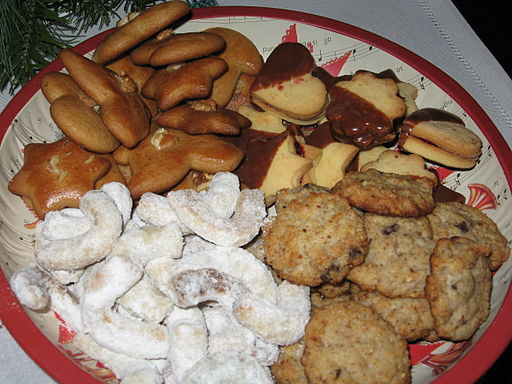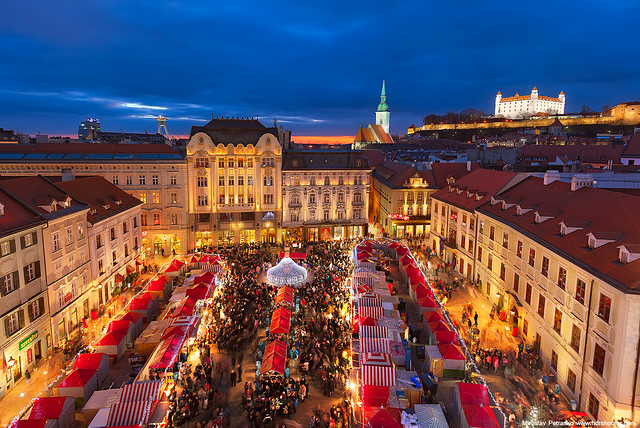Christmas in Slovakia

In Slovakia, Christmas celebrations begin with Advent. Many Slovaks are Roman Catholics so this is the start of the important spiritual preparations for Christmas.
Slovaks also celebrate St. Nicholas' day on the 6th December. In Slovakia he is known as Svätý Mikuláš. He comes on the evening of the 5th December and gives presents to good children. Young children place their shoes near the door so Svätý Mikuláš can fill them with sweets and fruit.
During Advent there are lots of preparations to be made for Christmas. This includes cleaning the house, baking, shopping and buying the Christmas Tree. Carps are also sold on the streets from big tanks (carp is eaten in the main Christmas meal).
Christmas Eve is the most important day during Christmas for Slovaks. It is called 'Stedry den' (the Generous Day). The actual evening is called 'Stedry vecer' (the Generous Evening) and the Christmas season is called 'Vianoce'.
In Slovakian Happy/Merry Christmas is 'Veselé Vianoce'. Happy/Merry Christmas in lots more languages.
Slovak Christmas Trees are decorated with colored lights, fruits, hand-made decorations made of wood, baked goods made with honey in the form of Angels and other religious symbols and sweets. Christmas Trees are kept until January 6th, the Feast of the Three Kings (Epiphany). Then the children are allowed to finally eat the candies and other sweets from the tree.
Christmas gifts are brought to children by the Ježíško (Baby Jesus). Family gifts are put under the Christmas Tree. A common tradition is that the children have to leave the room when the presents are being brought by Jesus. When they are there a bell is rung. The children then run to the Christmas Tree to try and see the Baby Jesus but they always narrowly miss him! Then the present are opened. Most people open their presents after the main Christmas meal, although some open them before they eat!
On Christmas Eve morning the carp is killed and gutted (or some other kind of fish is taken out of the freezer!). During the day the supper is cooked. It used to be the custom to fast (not eating certain foods) all through Christmas Eve. This was a direction given by the Catholic Church. It was said that if you manage to get by without food for the whole day, you will see a little golden pig in the evening (after the Midnight Mass service)!
The main Christmas meal is known as the 'velija' and consists of 12 dishes (the number of dishes symbolizes the number of Jesus's disciples). The table is prepared with a white table cloth with straw and sheaves of wheat at each end.
Christmas dinner begins with Oplatky small bread wafers and a blessing.
The main Christmas supper varies between regions and families. It normally has lots of courses including a fish dish and 'Kapustnica'. Kapustnica is a thick cabbage soup with sausage, meat, dried mushrooms and cream. Every family has its own recipe. Some recipes include ingredients that might seem unusual such as dried plums and apples.
Carp is often the fish that is eaten. Some people buy it live and keep it in their bath until it's time to kill it and cook it. And if you want a bath or shower, you have to take it out of the bath and put it in a bucket!
Other dishes might include a baked ham or a roost goose, 'bobajky' small pieces of bread mixed with butter and sauerkrat or sweetened with honey and poppyseeds, potato salad, pirohy dumplings, vegetables and plenty of walnut rolls or cookies.
Cookies are a popular dessert and treat at Christmas. Some favorites include vanilla ones made with poppy seeds and walnuts and apricot cookies. Sometimes people will make more than 10 different types of cookies. These are given to visitors over Christmas. There are also special thin waffles that are eaten with honey.

After supper people might visit the close family or neighbors and give small gifts. Then many people will go to a Midnight Mass Service. This is the busiest Church service of the year.
In Slovakia there are many regional variations of the Christmas Eve celebrations. Some are local folk customs and rituals, that date back many years. One tradition is to clean the house and windows ready for Christmas.
Christmas Day and the 26th are much quieter and days of rest. People might go to Holy Mass Service and visit their family on Christmas Day. Families with children like to go to church and watch 'Bethlehems' (crib scenes) which are displayed in almost every church. Some of them are mechanical!
